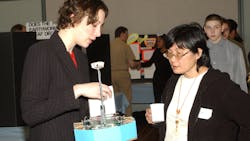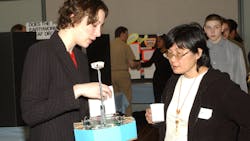For the record, I help run the Mercer Science and Engineering Fair (MSEF) in Mercer County, N.J. and have written about the International Science and Engineering Fair (ISEF) on numerous occasions. It is actually run by the Society for Science and the Public (SSP). Intel is the named sponsor, but only through 2019—a fact I find a little disheartening, especially given that I’m also an Intel shareholder.
All three of my children participated in MSEF, two competed in ISEF, and all of them are now practicing engineers. Laura (see photo) is a mechanical engineer, Robert is a chemical engineer, and Jennifer is a civil engineer. They might still have become engineers even without participating in these competitions, but they did have a major impact on them and their futures, along with millions of other fair participants.
The 2016 Intel ISEF was host to more than 1,700 young scientists selected from 419 affiliate fairs in 77 countries, regions, and territories from around the world. It is one of the most prestigious competitions around and it is sponsored by a who’s who of companies. At the top of that list is Intel, which in addition to ISEF, has also recently pulled out as the name sponsor of the Intel Science Talent Search (STS). Regeneron Pharmaceuticals, a biotechnology firm, is now the primary sponsor for the latter event.
So what’s up with Intel? It took over the primary sponsorship of ISEF from Westinghouse Electric in 1998 (Actually, there was no named sponsor for the 1997 competition). And will ISEF survive without Intel?
Definitely. Intel was the largest—but not the only—sponsor of ISEF. Hopefully another company will take over the named position in time for the 2020 competition. Broadcom is already the named sponsor for the Broadcom MASTERS competition for grades 6 through 8. ISEF is for grades 9 through 12.
So why is Intel departing from two major STEM competitions? At this point it has only said it is “extremely proud” to have supported ISEF and STS.
Westinghouse was undergoing major changes in the 1990s when it pulled out of ISEF. It picked up many companies (including CBS) that changed its focus. Intel has also been doing a lot of soul searching and buying, especially in the areas of user interfaces and artificial intelligence, but I think it has more to do with the man at the top.
Craig Barrett and Andrew Grove, past CEOs and chairmen of Intel, were both major supporters of the competition and prominent at the competitions Brian Krzanich, the current CEO, has not been. According to Barrett, now on the board of directors for SSP: “You might instead conclude that Intel is a company of the past, just like Westinghouse when they dropped [sponsorship of the national science fair in 1998].”
Intel will continue to fund Maker Faire and MakerCon, although they are one of many sponsors at these events. Likewise, these are more conference and tradeshows than competitions. Students may also be showing off their work at these venues in addition to competing in science fairs like ISEF and Google Science Fair. Maker Faire is relatively new, emerging in California in 2006.
Running these competitions is not cheap. ISEF runs about $6 million per year. We actually run MSEF for about $10,000, which is what many FIRST Robotics teams need. These costs are a fraction of what they effect in terms of students, parents, and teachers. Science, technology, engineering, and mathematics (STEM) competition costs pale in comparison to what is spent in other areas like sports.
ISEF has been around a long time, as has MSEF. We are celebrating out 64th year of competition and will be sending out grand prize winner to the 2017 ISEF competition. Still, it is often a struggle to get participants into the fair, let alone the necessary sponsorship for the competitions. In many cases, it is simply a matter of students not knowing about a competition. MSEF is one of four fairs that cover New Jersey. You can find local ISEF fairs on the SSP site. The other fairs in the state are the Northern Jersey Regional Science Fair, Jersey City Medical Center/Barnabas Health STEM Showcase, and the Delaware Valley Science Fairs.
STEM is important, and most support or at least give it lip service. Unfortunately, science and even engineering are under attack from various quarters. Hopefully Intel’s departure from these two competitions does not highlight a more general trend in our industry where STEM is such a critical component.
About the Author
William Wong Blog
Senior Content Director
Bill's latest articles are listed on this author page, William G. Wong.
Bill Wong covers Digital, Embedded, Systems and Software topics at Electronic Design. He writes a number of columns, including Lab Bench and alt.embedded, plus Bill's Workbench hands-on column. Bill is a Georgia Tech alumni with a B.S in Electrical Engineering and a master's degree in computer science for Rutgers, The State University of New Jersey.
He has written a dozen books and was the first Director of PC Labs at PC Magazine. He has worked in the computer and publication industry for almost 40 years and has been with Electronic Design since 2000. He helps run the Mercer Science and Engineering Fair in Mercer County, NJ.
- Check out more articles by Bill Wong on Electronic Design
- Bill Wong on Facebook
- @AltEmbedded on Twitter


